 W
WThe Afrin River (Arabic: نهر عفرين Nahr ʻIfrīn; is a tributary of the Orontes River in Turkey and Syria. It rises in the Kartal Mountains in Gaziantep Province, Turkey, flows south through the city of Afrin in Syria, then reenters Turkey. It joins the Karasu at the site of the former Lake Amik, and its waters flow to the Orontes by a canal.
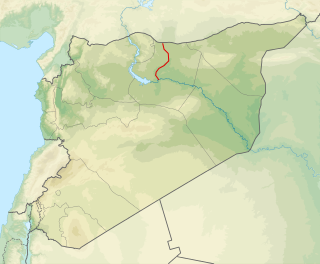 W
WThe Balikh River is a perennial river that originates in the spring of Ain al-Arous near Tell Abyad in the Eastern Mediterranean conifer-sclerophyllous-broadleaf forests ecoregion. It flows due south and joins the Euphrates at the modern city of Raqqa. The Balikh is the second largest tributary to the Euphrates in Syria, after the Khabur River. It is an important source of water and large sections have recently been subjected to canalization.
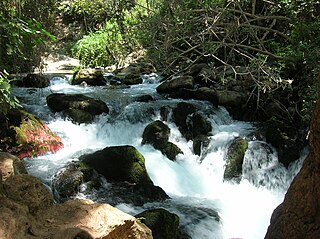 W
WBanias River is a river in the Israeli-occupied Golan Heights. It is the easternmost of the three main northern tributaries of the Jordan River; together with the Dan River and the Snir Stream, it forms the Jordan River's upper catchment (UCJR). Israel has included the stream in the Hermon nature reserve.
 W
WThe Barada is the main river of Damascus, the capital city of Syria.
 W
WThe Euphrates is the longest and one of the most historically important rivers of Western Asia. Together with the Tigris, it is one of the two defining rivers of Mesopotamia. Originating in the Armenian Highlands of eastern Turkey, the Euphrates flows through Syria and Iraq to join the Tigris in the Shatt al-Arab, which empties into the Persian Gulf.
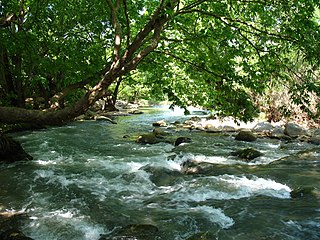 W
WThe Hasbani River or Snir Stream, is the major tributary of the Jordan River. Local natives in the mid-19th century knew the river as the Upper Jordan.
 W
WThe Jaghjagh River is a tributary of the Khabur River in Turkey and Syria.
 W
WThe Jordan River or River Jordan, also known as Nahr Al Sharieat, is a 251-kilometre-long (156 mi) river in the Middle East that flows roughly north to south through the Sea of Galilee and on to the Dead Sea. Jordan and the Golan Heights border the river to the east, while the West Bank and Israel lie to its west. Both Jordan and the West Bank take their names from the river.
 W
WThe Nahr al-Kabir, also known in Syria as al-Nahr al-Kabir al-Janoubi or in Lebanon simply as the Kebir, is a river in Syria and Lebanon flowing into the Mediterranean Sea at Arida. The river is 77.8 km (48.3 mi) long, and drains a watershed of 954 km2 (368 sq mi). Its headwaters are at the Ain as-Safa spring in Lebanon and it flows through the Homs Gap.
 W
WNahr al-Kabir al-Shamali is a river in Latakia Governorate, Syria.
 W
WThe Khabur River is the largest perennial tributary to the Euphrates in Syria. Although the Khabur originates in Turkey, the karstic springs around Ras al-Ayn are the river's main source of water. Several important wadis join the Khabur north of Al-Hasakah, together creating what is known as the Khabur Triangle, or Upper Khabur area. From north to south, annual rainfall in the Khabur basin decreases from over 400 mm to less than 200 mm, making the river a vital water source for agriculture throughout history. The Khabur joins the Euphrates near the town of Busayrah.
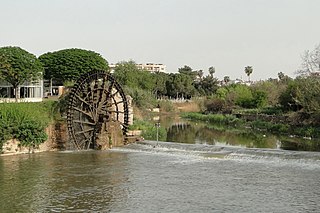 W
WThe Orontes or Asi is a 571-kilometer-long (355 mi) river in Western Asia that begins in Lebanon, flowing northwards through Syria before entering the Mediterranean Sea near Samandağ in Turkey.
 W
WThe Queiq, with many variant spellings, anciently known as the Belus and Chalos, and also known in English as the Aleppo River, is a river and valley of the Aleppo Governorate, Syria and Turkey. It is a 129 kilometres (80 mi)-long river that flows through the northern Syrian city of Aleppo. It arises from the southern Aintab plateau in southeastern Turkey. The Akpınar River in the Kilis plain is one of the headwaters of the Queiq. The former town of Qinnasrin lay on its banks. It partly flows along the western rim of the Matah Depression. The valley has been occupied for thousands of years and in ancient times the Queiq valley was noted for its flint industries and pottery.
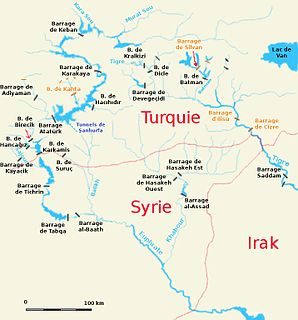 W
WThe Sājūr River is a 108 kilometres (67 mi) long river originating in Turkey and flowing into the Euphrates in Syria. It is the smallest of the three rivers joining the Euphrates in Syria, and the only one that joins the Euphrates on its right bank. Occupation in the Sājūr basin started in the Lower Palaeolithic period and continues until today.
 W
WThe Tigris is the eastern of the two great rivers that define Mesopotamia, the other being the Euphrates. The river flows south from the mountains of the Armenian Highlands through the Syrian and Arabian Deserts, and empties into the Persian Gulf.